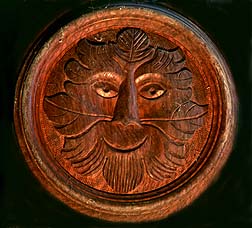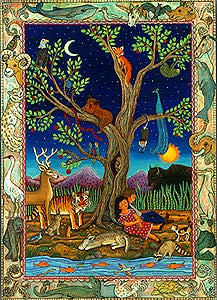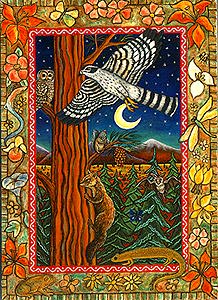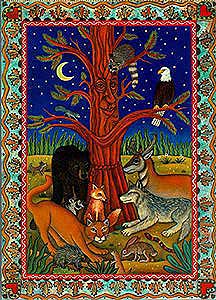Traveling within the World
Linking your favorite traveling artists across the globe
|
|
Introduction
The word 'Shaman,' is actually a Tungus (Siberian) word for a spiritual practice that is as old as mankind, and is still practiced by indigenous people, as well as modern practitioners worldwide. Shamanism is not rooted in any organized religious tradition, but is instead a system of controlled visionary journeys into alternate realities (and back,) in order to contact spirit guides and gain their assistance in divination and healing.
 |
When one thinks of traditional shamans and shamanism, its easy to envision a Native (American or perhaps Aboriginal) medicine man performing rituals that are deeply rooted in cultural tribal traditions. It is important to note that the ancient Celts were also believed to have practiced shamanism, and have left many clues to their rituals and spiritual journeys in the stories of Taliesin, Fionn mac Cumhail, and Amergin. |
The Celtic Shaman's Universe
The Celtic Shaman's cosmos, like that of other Shamanic universal views, consists of three 'worlds;' the Lower world, the Upper world, and the Middle world (where we live in ordinary reality.)
What differentiates the Celtic Shaman's universal view from that of other Shamanic traditions, is that these worlds are all connected by the great tree of life. Rooted in the Lower realm, its trunk extends upwards, through the middle world and into the Upper world, where its branches hold the stars, the sun and the moon.
| The Celtic Shaman traverses the realms by climbing the tree (also seen as a great ladder or pole) into the Upper world. This is the realm of stars, celetial beings, and is the dwelling place of many gods and spirits of the air, and of the great Mother Goddess herself. The lower world can be reached by descending the roots of the massive tree into the realm of the spirits of the earth and fire, where sits the stag-headed Lord of the Underworld, the horned one, protector of the animals. Here the Celtic Shaman can meet with helper power animals and spirit guides. |
 Image by Diana Bryer |
Thus all three worlds are linked by the great tree, and yet the tree itself and all of the universe are believed contained within the shell of a single hazelnut, lying next to the Well of Segais (the source of all wisdom.)
Shapeshifting
Shapeshifting is an integral part of the Celtic Shamanic experience. The great Amergin had to commune and fuse his consciousness with the totality of Ireland in order to help the Milesians to conquer it.
| I am the wind that blows across the sea; I am a wave of the deep; I am the roar of the ocean; I am the stag of seven battles; I am a hawk on the cliff; I am a ray of sunlight; I am the greenest of plants; I am a wild boar; I am a salmon in the river; I am a lake on the plain; I am the word of knowledge; I am the point of a spear; I am the lure beyond the ends of the earth; I can shift my shape like a god. - from the Song of Amergin |
The ability to be simultaneously a part of many realities and existences is at the heart of the shamanic experience. The Celtic shaman deliberately seeks to take on the shape of another animal or being in order to call upon the power within the entity for healing or instruction. The ability of the shaman to send his or her own consciousness into the consciousness of another being and then return to one's own self is integral to the shaman's journey.
The Welsh bard Taliesin, often said to be the father of Celtic shamanism, also alluded to shapeshifting when he claimed:
| I have been in many shapes: I have been a narrow blade of a sword; I have been a drop in the air; I have been a shining star; I have been a word in a book; I have been an eagle; I have been a boat on the sea; I have been a string on a harp; I have been enchanted for a year in the foam of water. There is nothing in which I have not been. - Taliesin |
Taliesin was also known to have transformed himself into many other forms and guises in his attempt to escape the Goddess Ceridwen after imbibing of the brew of inspiration and wisdom.
The Totem Beasts
In shamanic traditions, all people are guarded and watched over by a totem beast, which joins them at the time of their birth. In addition to this totem animal, which can remain with a person throughout their life, the shamanic practitioner acquires additional power animals at different times. These animal spirits serve as guides and spirit helpers. They may come of their own bidding, or may be called specifically because of their innate skills. In some cases the shaman draws upon the strength, the speed or the intuition of a particular animal, or the sharpness of the animals senses. In other situations the animal may tell the shaman things which the shaman cannot see for his or herself.
 Image by Diana Bryer |
At earlier times in our existence on this earth, mankind and the animal kingdom where much closer in relations (living proximity,) and in understanding. As our society has become more and more mechanized, we have lost much of our sense of kinship with our animal brethren. The shaman is trained to retain this understanding through his or her association with the spirit realm, and with the particular spirits that represent the many species of the animal world. |
For Additional Information
For more information about Celtic Shamanism, the following references are invaluable:
The Celtic Shaman - A Handbook, by John Matthews
Fire in the Head - Shamanism and the Celtic Spirit, by Tom Cowan
The Encyclopaedia of Celtic Wisdom, by Caitlin & John Matthews
Tags:
Replies to This Discussion
Events
-
2014 is the Chinese Year of the Horse
February 17, 2026 at 12am to February 5, 2027 at 12am – where & how you choose
Birthdays
Birthdays Today
Birthdays Tomorrow
Important (read & understand)
Skype: Travelingraggyman
Email and Instant Messenger:
TravelerinBDFSM @ aol/aim; hotmail; identi.ca; live & yahoo
OR
Travelingraggyman @ gmail and icq ***

1AWARD UPDATES & INFORMATION
10,000 votes - Platinum Award
5,000 votes - Gold Award
2,500 votes - Silver Award
1,000 votes - Bronze Award
300 votes - Pewter Award
100 votes - Copper Award
Member of the Associated Posting System {APS}
This allows members on various sites to share information between sites and by providing a by line with the original source it credits the author with the creation.
Legal Disclaimer
***************We here at Traveling within the World are not responsible for anything posted by individual members. While the actions of one member do not reflect the intentions of the entire social network or the Network Creator, we do ask that you use good judgment when posting. If something is considered to be inappropriate it will be removed
Site Meter
This site is strictly an artist operational fan publication, no copyright infringement intended
Patchwork Merchant Mercenaries had its humble beginnings as an idea of a few artisans and craftsmen who enjoy performing with live steel fighting. As well as a patchwork quilt tent canvas. Most had prior military experience hence the name.
Patchwork Merchant Mercenaries.
Vendertainers that brought many things to a show and are know for helping out where ever they can.
As well as being a place where the older hand made items could be found made by them and enjoyed by all.
We expanded over the years to become well known at what we do. Now we represent over 100 artisans and craftsman that are well known in their venues and some just starting out. Some of their works have been premiered in TV, stage and movies on a regular basis.
Specializing in Medieval, Goth , Stage Film, BDFSM and Practitioner.
Patchwork Merchant Mercenaries a Dept of, Ask For IT was started by artists and former military veterans, and sword fighters, representing over 100 artisans, one who made his living traveling from fair to festival vending medieval wares. The majority of his customers are re-enactors, SCAdians and the like, looking to build their kit with period clothing, feast gear, adornments, etc.
Likewise, it is typical for these history-lovers to peruse the tent (aka mobile store front) and, upon finding something that pleases the eye, ask "Is this period?"
A deceitful query!! This is not a yes or no question. One must have a damn good understanding of European history (at least) from the fall of Rome to the mid-1600's to properly answer. Taking into account, also, the culture in which the querent is dressed is vitally important. You see, though it may be well within medieval period, it would be strange to see a Viking wearing a Caftan...or is it?
After a festival's time of answering weighty questions such as these, I'd sleep like a log! Only a mad man could possibly remember the place and time for each piece of kitchen ware, weaponry, cloth, and chain within a span of 1,000 years!! Surely there must be an easier way, a place where he could post all this knowledge...
Traveling Within The World is meant to be such a place. A place for all of these artists to keep in touch and directly interact with their fellow geeks and re-enactment hobbyists, their clientele.
© 2025 Created by Rev. Allen M. Drago ~ Traveler.
Powered by
![]()
